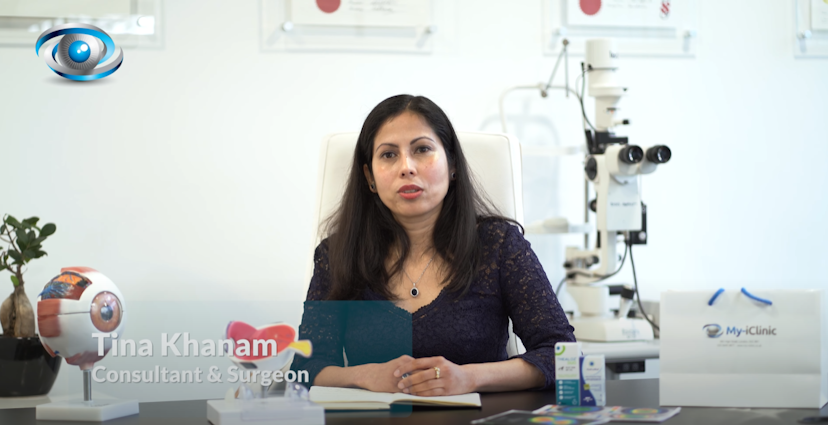
10 Facts You Should Know Before Walking Into An Eye Clinic
Your eyes are a window to the world, providing you with the ability to see and experience the beauty around you. However, when faced with eye problems or discomfort, seeking professional help becomes paramount to safeguarding this precious sense. Whether you are experiencing blurry vision, eye strain, or any other visual concern, considering an eye clinic for your eye care needs can be a wise decision.
Eye clinics house a team of specialised professionals equipped with the knowledge and technology to diagnose, treat, and manage various eye conditions. In this fast-paced world, where digital devices and environmental factors can strain our eyes, taking a proactive approach to address eye problems is essential. This article explores the reasons why choosing an eye clinic should be your priority when dealing with your eyes, and how it can lead you towards clearer vision and improved eye health.
1. A Local Eye Clinic Near Me
Finding a local eye clinic offers a myriad of benefits for the community, making it an important resource for local people, especially if you live in a large city like London. First and foremost, proximity plays a crucial role in accessibility. Local eye clinics provide convenience, allowing individuals to access essential eye care services without the need for long-distance travel, saving time and effort.
Moreover, being close to home encourages regular check-ups and follow-up visits, which are vital for maintaining good eye health. Local eye clinics also foster a sense of trust and familiarity among residents, knowing that the clinic is part of their community. This familiarity can lead to a more personalised and compassionate approach to patient care, as eye care professionals become attuned to the specific needs and concerns of local individuals.
Additionally, local eye clinics contribute to the overall well-being of the community by promoting eye health awareness and education, creating a healthier and more informed population. In times of emergencies, vision correction or urgent eye treatments, having a local eye clinic readily available can be invaluable, providing prompt and reliable care when it matters most. Therefore, for the local general public, finding a nearby eye clinic offers a host of advantages, ensuring that quality eye care remains accessible, comfortable, and responsive to the unique needs of the community.
2. What Is The Experience, Qualifications and Reputation Of The Eye Clinic?
In the UK, becoming an eye surgeon specialising in vision correction and eye treatments requires rigorous education, training, and certification. Eye surgeons must complete a medical degree (MBBS or equivalent) followed by several years of postgraduate training in ophthalmology. During this training, aspiring eye surgeons gain comprehensive knowledge of the eye's anatomy, various eye conditions, and surgical techniques for vision correction and eye treatments. After completing their training, they typically undergo further specialisation in specific areas such as refractive surgery, cataract surgery, corneal transplantation, or other subspecialties related to eye health.
One of the essential criteria for an eye surgeon in the UK is registration with the General Medical Council (GMC). This registration ensures that the surgeon is fully qualified and meets the required standards of competence and professionalism. Additionally, many eye surgeons pursue membership or fellowship with reputable ophthalmic organisations such as the Royal College of Ophthalmologists (RCOphth) or the British Society for Refractive Surgery (BSRS), demonstrating their commitment to continuous learning and best practices in the field.
The importance of these qualifications for customers and the reputation of the eye clinic cannot be overstated. Customers seeking vision correction or eye treatments place their trust in the expertise and skill of the eye surgeon. Proper qualifications provide assurance that the surgeon has undergone rigorous training, adheres to high professional standards, and has the necessary experience to perform complex procedures safely and effectively. Customers are more likely to feel confident and at ease knowing that their eye care is in the hands of a qualified professional.
For My-iClinic, having highly qualified eye surgeons enhances the reputation and credibility within the community and the medical industry. Positive patient experiences and successful eye treatments contribute to word-of-mouth referrals and positive reviews, further solidifying the clinic's reputation as a trusted provider of eye care services. Additionally, the clinic's association with reputable medical organisations and certified eye surgeons may open up opportunities for collaborations, research, and advancements in eye care, ultimately benefiting both the clinic and its patients.

3. What Are The Most Common Eye Problems In The UK?
In the UK, several common eye problems affect a significant portion of the population. It’s good to understand that you are not alone when it comes to eye care or seeking help with a possible problem.
Some of the most prevalent eye conditions include:
Refractive Errors
Refractive errors, such as nearsightedness (myopia), farsightedness (hyperopia), and astigmatism, are widespread in the UK. These conditions affect the eye's ability to focus light properly on the retina, leading to blurred vision and difficulties in seeing objects at various distances.
Cataracts
Cataracts are a common age-related eye condition characterised by the clouding of the eye's natural lens. This can cause progressive vision impairment and may require surgical intervention to replace the cloudy lens with an artificial one.
Age-related Macular Degeneration (AMD)
AMD is a leading cause of vision loss in people over the age of 50 in the UK. It affects the macula, the central part of the retina, leading to loss of central vision and difficulty in performing tasks like reading and recognising faces.
Glaucoma
Glaucoma is a group of eye conditions that cause damage to the optic nerve, often due to increased intraocular pressure. It can result in gradual vision loss and, if left untreated, may lead to permanent blindness.
Dry Eye Syndrome
Dry eye is a common condition in which the eyes do not produce enough tears or have poor tear quality, causing discomfort, irritation, and sometimes blurred vision.
Blepharitis
Blepharitis is an inflammation of the eyelids, usually caused by a buildup of bacteria or skin oils. It can lead to redness, itching, and crusting of the eyelids.
Diabetic Retinopathy
People with diabetes may develop diabetic retinopathy, a condition where high blood sugar levels damage the blood vessels in the retina, leading to vision problems and potential vision loss.
Strabismus
Strabismus, also known as "crossed eyes" or "lazy eye," is a condition in which the eyes do not align properly, leading to double vision and reduced depth perception.
Presbyopia
Presbyopia is a condition that commonly occurs with age, causing difficulty in focusing on near objects due to the gradual loss of the eye's ability to change focus.
It's essential to address any changes in vision or discomfort promptly and seek professional eye care to diagnose and manage these common eye problems effectively.

4. What Vision Correction Services Can Help With Eye Conditions?
Vision correction services can be beneficial for people suffering from various eye problems, helping them improve their vision and overall eye health. Some common vision correction services include:
Cataract Surgery
Cataract surgery is a vision correction procedure for individuals with cataracts. During the surgery, the clouded natural lens is removed and replaced with an artificial intraocular lens (IOL), restoring clear vision and often reducing the need for glasses after the procedure.
LASIK, SMILE and Refractive Surgeries
LASIK (Laser-Assisted In Situ Keratomileusis), SMILE (Small Incision Lenticule Extraction) and other refractive surgeries are performed to correct refractive errors and reduce or eliminate the need for glasses or contact lenses. These procedures reshape the cornea to improve how light is focused onto the retina.
Intraocular Lens Implant
Intraocular lens implants, such as multifocal or accommodating IOLs, can be used during cataract surgery or as standalone procedures to address myopia or presbyopia and provide clear vision at various distances.
Treatments for Eye Diseases
Vision correction services also encompass treatments for eye diseases like glaucoma, diabetic retinopathy, and age-related macular degeneration. These treatments aim to manage the condition and preserve vision to the best possible extent.
Dry Eye Treatments
For individuals with dry eye syndrome, various treatments are available, including artificial tears, prescription eye drops, punctal plugs to retain tears, and lifestyle modifications to improve eye comfort and lubrication.
Vision Therapy
Vision therapy is a specialised program that can help improve visual skills and efficiency for individuals with certain eye conditions, such as strabismus or amblyopia (lazy eye).
Regular eye exams are crucial for the early detection of eye problems and to ensure that the chosen vision correction services continue to meet the person's needs over time.
5. Eye Checks And Procedures On Your First Visit
At an eye clinic, a range of eye checks and procedures are performed to assess the health of the eyes, detect vision problems, and diagnose any underlying eye conditions. These assessments are typically conducted by qualified eye care professionals, such as optometrists and ophthalmologists. Below are some common eye checks and procedures that patients can expect at an eye clinic:
Comprehensive Eye Examination
A comprehensive eye examination is a fundamental assessment that evaluates the overall health of the eyes and assesses vision. It usually includes tests for visual acuity (measuring how well a person can see), refraction (determining the need for glasses or contact lenses), and assessments of eye muscle function, eye pressure, and peripheral vision.
Slit-lamp Examination
The slit-lamp examination allows eye care professionals to examine the structures of the eye in detail. It uses a specialised microscope with a thin, intense beam of light to visualise the cornea, iris, lens, and other parts of the eye. This examination is useful for detecting abnormalities, such as corneal injuries or cataracts.
Dilated Eye Examination
In a dilated eye examination, eye drops are used to enlarge the pupils, allowing the eye care professional to examine the retina and optic nerve at the back of the eye. This is essential for detecting conditions like age-related macular degeneration, diabetic retinopathy, and glaucoma.
Tonometry
Tonometry measures the pressure inside the eye and is crucial in diagnosing glaucoma, a condition that can lead to vision loss if left untreated. There are various methods of tonometry, including the use of a gentle puff of air or a specialised instrument to touch the eye's surface.
Visual Field Test
The visual field test evaluates a person's peripheral vision. It is useful for detecting conditions like glaucoma or neurological issues that may affect a person's field of view.
Retinal Imaging
Retinal imaging involves capturing detailed images of the retina using specialised cameras. It aids in the early detection of eye diseases and helps monitor any changes for retina treatment over time.
Refractive Surgery Consultation
For individuals considering refractive surgery, such as LASIK, SMILE or PRK, the eye clinic may offer consultations to assess their suitability for the procedure and discuss potential risks and benefits.
These are just a few examples of the eye checks and procedures that commonly take place at an eye clinic. The specific tests and assessments performed will vary based on the patient's age, medical history, and any existing eye concerns or symptoms they may have.

6. Why Are Eye Examinations Important?
An eye examination is not only essential for assessing vision but also plays a crucial role in catching early signs of various eye diseases and conditions. During an eye examination at My- iClinic, eye care professionals conduct a series of tests to evaluate the health of the eyes and detect any abnormalities that may indicate the presence of eye disease. Early detection is critical because many eye conditions if left untreated, can lead to vision loss or other serious complications.
Eye care professionals look out for signs of common eye diseases such as glaucoma, cataracts, age-related macular degeneration (AMD), diabetic retinopathy, and more. For instance, during a dilated eye examination, the eye care professional can examine the retina and optic nerve, looking for signs of retinal damage or changes in the blood vessels that could indicate diabetic retinopathy. This early detection allows for timely intervention and management of diabetes-related eye complications.
Another example is glaucoma, which can lead to irreversible vision loss if not diagnosed and treated early. Through tonometry, which measures intraocular pressure, eye care professionals can identify elevated eye pressure, a key indicator of glaucoma. Early detection enables the implementation of treatment to control the pressure and prevent further damage to the optic nerve.
Cataracts, a clouding of the eye's natural lens, can also be detected during an eye examination. By performing a comprehensive eye examination and slit-lamp examination, eye care professionals can assess the clarity of the lens and determine the severity of cataracts. Early diagnosis allows patients to plan for cataract surgery when appropriate, restoring clear vision and improving their quality of life.
Furthermore, an eye examination can uncover general health issues that may not be immediately related to the eyes. For instance, the condition of blood vessels in the retina can provide insights into a person's overall cardiovascular health.
An eye examination at My-iClinic is a vital preventive measure for catching early signs of eye diseases and conditions. It allows eye care professionals to monitor eye health, identify potential issues, and provide timely interventions or referrals to specialists when needed.
7. What Should You Bring To An Eye Clinic Appointment?
When seeking vision correction or surgery at an eye clinic in the UK, it's important to be well-prepared for the appointment. Here are some essential items and information that a person should bring:
Medical History
Prepare a detailed medical history, including any past eye conditions, surgeries, or eye-related issues. Also, inform the clinic about any underlying health conditions and medications you are currently taking, as these may have implications for your eye care and surgery planning.
Insurance Information
If you have health insurance that covers eye care or vision correction procedures, bring your insurance policy, pre-authorisation numbers and any relevant documents. This will facilitate the billing process and ensure that you are aware of any potential out-of-pocket expenses.
Eyewear
If you wear glasses or contact lenses, bring them to the appointment. The eye care professional may want to review your current prescription or make adjustments based on your eye exam results.
List of Questions
Prepare a list of questions and concerns you have regarding vision correction or surgery. This will ensure that you address all your queries during the appointment and gain a comprehensive understanding of your options and the procedure itself.
Supportive Person
Consider bringing a family member or friend with you to the appointment, especially if you are considering surgery. Having a supportive person can help you remember important details discussed during the appointment and provide emotional support.
Transportation Arrangements
If you are undergoing a procedure that may temporarily affect your vision, such as dilation or surgery, arrange for transportation to and from the clinic as your vision may be impaired for a few hours after the appointment.
By preparing these items and information beforehand, you can ensure a smooth and productive clinic appointment for vision correction or surgery. Our eye care professionals will have a comprehensive understanding of your eye health and needs, allowing them to provide personalised care and recommendations tailored to your specific situation.
8. What Questions Should I Ask My Eye Clinic Before Surgery or Treatment?
Before undergoing corrective eye surgery or eye treatment, it's essential to ask your eye clinic a series of important questions to ensure you have a clear understanding of the procedure and what to expect. Here are some crucial questions to consider:
Am I a suitable candidate for the surgery? Ask the eye clinic about the criteria for being a suitable candidate for the specific corrective eye surgery you are considering. Factors such as your age, eye health, prescription stability, and overall health may impact your eligibility.
What are the potential risks and complications? Gain a comprehensive understanding of the potential risks and complications associated with the surgery. Ask the eye clinic to explain any specific risks that apply to your individual situation.
What are the expected outcomes and recovery time? Discuss the expected visual outcomes and the typical recovery process for the surgery. Understand the timeline for achieving optimal results and when you can resume regular activities.
How experienced is the surgeon? Inquire about the surgeon's experience and expertise in performing the particular type of corrective eye surgery you are considering. Ask about their success rate and how many similar procedures they have performed.
What are the alternatives to surgery? Discuss alternative vision correction options, such as glasses or contact lenses, and how they compare to the proposed surgery in terms of effectiveness and safety.
What are the preoperative and postoperative instructions? Understand the preoperative preparations required, including any restrictions on medications or activities leading up to the surgery. Also, ask about the postoperative care plan and any precautions you need to take during the recovery period.
What are the costs and payment options? Inquire about the total cost of the surgery, including any additional fees or potential postoperative expenses. Ask about available payment options and whether the clinic accepts insurance coverage.
Can I speak with previous patients? Request testimonials or the opportunity to speak with previous patients who have undergone the same procedure. Hearing about their experiences can provide valuable insights and help alleviate any concerns.
How long will the results last? Understand the longevity of the surgery's results and if there is a possibility of regression or the need for further enhancements in the future.
Is there a guarantee or revision policy? Inquire about any guarantees or revision policies offered by the eye clinic in case the desired outcomes are not achieved or if any issues arise after the surgery.
Asking these questions will empower you to make an informed decision about your corrective eye surgery and choose the best possible option for your individual needs and expectations.

9. What Sets Apart The Various Types Of Laser Eye Surgery?
ReLEx SMILE (Small Incision Lenticule Extraction), LASIK (Laser-Assisted In Situ Keratomileusis), LASEK (Laser-Assisted Sub-Epithelial Keratectomy), PRK (Photorefractive Keratectomy), and PTK (Phototherapeutic Keratectomy) are all types of laser eye surgeries that aim to correct refractive errors and certain corneal conditions. While they share some similarities, there are significant differences in how these procedures are performed and the recovery process. Here's a brief overview of each:
ReLEx SMILE Laser Eye Surgery
ReLEx SMILE (Small Incision Lenticule Extraction) is a type of laser eye surgery used to correct myopia (nearsightedness) and astigmatism. It is a relatively newer and minimally invasive procedure that has gained popularity in the field of refractive surgery.
In ReLEx SMILE, the surgeon uses a femtosecond laser to create a thin, disc-shaped lenticule within the cornea. This lenticule contains the part of the cornea that needs to be removed to correct the refractive error. Unlike other laser surgeries like LASIK or ReLEx SMILE does not involve creating a corneal flap.
The procedure is typically performed as follows:
1. Anaesthetic eye drops are used to numb the eye, ensuring that the procedure is painless.
2. A femtosecond laser is used to create a small incision on the surface of the cornea. This incision is usually around 2 to 4 mm in length.
3. The laser then creates a lenticule (a small lens-shaped piece of corneal tissue) inside the cornea, which corresponds to the refractive error of the eye.
4. Once the lenticule is created, the surgeon removes it through the small incision made earlier, which effectively reshapes the cornea to correct the myopia or astigmatism.
5. The cornea heals naturally without the need for sutures, as the small incision is self-sealing.
Benefits of ReLEx SMILE over traditional procedures like LASIK include a reduced risk of dry eye complications, a lower chance of corneal biomechanical weakening, and a potentially faster recovery time. Additionally, the absence of a corneal flap decreases the risk of flap-related complications.
ReLEx SMILE may not be suitable for all individuals, and it is crucial to consult with an experienced eye surgeon to determine the best treatment option based on an individual's eye health and specific refractive error.
LASIK (Laser Assisted In Situ Keratomileusis)
LASIK (Laser-Assisted In Situ Keratomileusis) is a popular and widely performed laser eye surgery used to correct refractive errors such as myopia (nearsightedness), hyperopia (farsightedness), and astigmatism. The procedure aims to reshape the cornea, the clear front surface of the eye, to improve how light is focused on the retina, thus reducing the need for glasses or contact lenses.
Here's an overview of how LASIK eye surgery is typically performed:
1. Anaesthetic eye drops are used to numb the eye, ensuring that the procedure is painless.
2. The surgeon creates a thin flap on the cornea using a femtosecond laser. The flap acts like a hinged door, providing access to the underlying corneal tissue.
3. The surgeon then lifts the corneal flap and uses an excimer laser to remove a precise amount of corneal tissue from the exposed layer. The laser removes tissue in a controlled and highly accurate manner without generating heat.
4. The removal of corneal tissue reshapes the cornea, correcting the refractive error. For myopia, the cornea is flattened, and for hyperopia, it is steepened. For astigmatism, the laser smoothes the irregular shape of the cornea.
After the cornea is reshaped, the surgeon carefully repositions the corneal flap back in place, where it adheres without the need for stitches due to the cornea's natural bonding properties.
The procedure is usually performed on both eyes during the same session and typically takes only a few minutes per eye. Patients may experience improved vision almost immediately after the surgery, although it may take a couple of days for the full effects to be realised.
LASIK surgery has a high success rate and is considered a safe and effective procedure for many people with refractive errors. It is essential to consult with an experienced eye surgeon to determine if LASIK is the right option for an individual based on their eye health, refractive error, and other factors.
LASEK (Laser-Assisted Sub-Epithelial Keratectomy)
LASEK (Laser-Assisted Sub-Epithelial Keratectomy) is a type of laser eye surgery that is used to correct refractive errors such as myopia (nearsightedness), hyperopia (farsightedness), and astigmatism. LASEK is similar to LASIK in its objective of reshaping the cornea to improve vision, but it differs in the way the cornea's surface layer, called the epithelium, is treated.
Here's an overview of how LASEK eye surgery is typically performed:
1. The surgeon applies anaesthetic eye drops to numb the eye and then uses a diluted alcohol solution to loosen and partially detach the thin layer of epithelial cells from the cornea's surface.
2. After the epithelium is loosened, the surgeon gently moves it aside to expose the underlying cornea.
3. Using an excimer laser, the surgeon precisely removes a specific amount of corneal tissue to reshape the cornea, correcting the refractive error.
4. Once the cornea is reshaped, the surgeon repositions the epithelial layer back onto the cornea's surface.
5. A soft contact lens is placed on the eye to protect the epithelium as it heals and promotes a smooth recovery.
Compared to LASIK, LASEK involves no flap at all. This makes LASEK a potentially suitable option for patients with thinner corneas, who may not be eligible for LASIK due to safety
concerns.
PRK (Photorefractive Keratectomy)
PRK (Photorefractive Keratectomy) is a type of laser eye surgery used to correct refractive errors such as myopia (nearsightedness), hyperopia (farsightedness), and astigmatism. PRK is one of the earliest forms of laser vision correction and paved the way for other procedures like LASIK and LASEK.
Here's an overview of how PRK eye surgery is typically performed:
1. The surgeon applies anaesthetic eye drops to numb the eye and then removes the thin, outermost layer of the cornea called the epithelium. This is usually done using an alcohol solution or a gentle mechanical scraping.
2. Once the epithelium is removed, the cornea's surface is exposed, and the surgeon uses an excimer laser to precisely reshape the cornea by removing a specific amount of corneal tissue.
3. The laser ablation reshapes the cornea, correcting the refractive error. For myopia, the cornea is flattened, and for hyperopia, it is steepened. For astigmatism, the irregular shape of the cornea is smoothened.
4. After the cornea is reshaped, a soft contact lens or a special bandage contact lens is placed on the eye to protect the cornea during the initial healing phase.
The main difference between PRK and LASIK/LASEK is the way the cornea's surface is treated. While LASIK involves creating a corneal flap, and LASEK involves partially detaching the epithelium, PRK completely removes the epithelium before applying the laser treatment directly to the cornea's surface. Because of this, PRK has a longer initial recovery period compared to LASIK and LASEK.
During the first few days after PRK surgery, the epithelium regenerates and heals over the treated area. It usually takes several days to a week for the epithelium to fully heal, and vision may be blurred during this time. As the eye heals, the vision gradually improves, and patients can experience stable visual outcomes in a few weeks to a few months after the surgery.
PRK may be a suitable option for individuals with thinner corneas or those with occupations or activities that increase the risk of corneal flap complications associated with LASIK.
PTK (Phototherapeutic Keratectomy)
PTK (Phototherapeutic Keratectomy) is a type of laser eye surgery used to treat various corneal surface problems, such as corneal dystrophies, corneal scars, recurrent corneal erosions, and superficial corneal irregularities. Unlike procedures like LASIK, LASEK, or PRK, PTK is not primarily intended to correct refractive errors like myopia, hyperopia, or astigmatism, although it may have some effect on vision in certain cases.
Here's an overview of how PTK eye surgery is typically performed:
1. The surgeon applies anaesthetic eye drops to numb the eye and prepares the cornea's surface for the laser treatment.
2. The excimer laser is used to remove the abnormal or damaged corneal tissue. The laser ablates the targeted area with high precision, removing very thin layers of tissue.
3. The removal of the damaged tissue allows the cornea to heal and regenerate properly, improving its clarity and smoothness.
PTK is a versatile procedure that can address a wide range of corneal surface issues, but it is not typically used to correct refractive errors like nearsightedness, farsightedness, or astigmatism as its primary purpose.
After the PTK procedure, patients may experience some discomfort and sensitivity in the treated eye. The healing process can take several days to weeks, depending on the extent of the corneal issue being addressed. During the recovery period, patients may be prescribed medicated eye drops and given specific instructions to aid in healing and prevent infection.
It's important to note that the suitability of each procedure depends on various factors, including the patient's eye health, corneal thickness, and the type and degree of refractive error or corneal condition. It's crucial to consult with an experienced eye surgeon to determine the most appropriate laser eye surgery option based on individual circumstances and visual needs.

10. Do You Offer Eye Surgery Finance Options?
My-iClinic offers no-interest finance options to help individuals manage the costs of eye surgery. Many private eye clinics offer flexible payment plans, allowing patients to spread the cost of the procedure over several months or years. These payment plans typically come with little to no interest, making it easier for patients to budget for their surgery without incurring additional financial burden. Additionally, some clinics partner with reputable medical financing companies that specialise in providing loans for medical procedures. These financing options often offer competitive interest rates and customisable repayment terms to suit the patient's financial situation. Moreover, patients may explore the possibility of using private health insurance to cover a portion of the eye surgery cost, depending on their policy coverage and the specific procedure involved. Overall, the availability of various financial options makes eye surgery more accessible to individuals seeking vision correction or other eye treatments in the UK.
See The World Clearly With London’s Number 1 Eye Clinic
Are you ready to experience exceptional eye care and take charge of your eye health? At My-iClinic, we are dedicated to providing you with the highest quality of eye care services.
It's time to take the next step and schedule your comprehensive eye examination with our expert team of eye care professionals.
Our state-of-the-art eye clinic is equipped with the latest technology to ensure accurate diagnoses and personalised treatment plans. Whether you're seeking vision correction, considering laser eye surgery, or need treatment for an eye condition, we've got you covered. Your eyes are precious, and our commitment is to preserve and enhance your vision for years to come.
Your vision is our priority, and we look forward to providing you with exceptional care at My-iClinic.
Find out more by Speaking to our team









